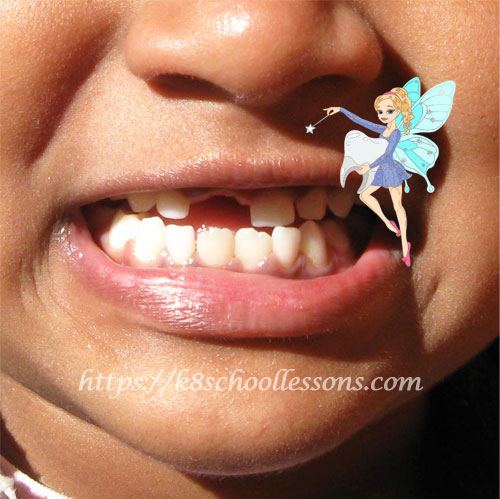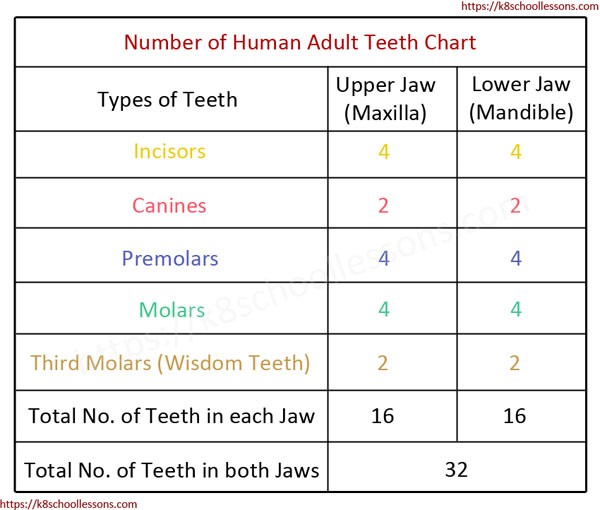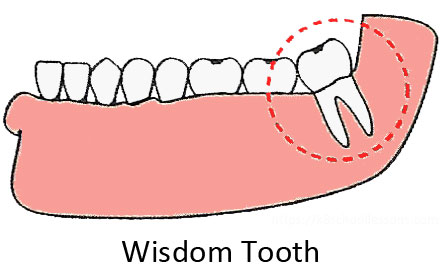Types of Teeth
Five different types of teeth erupt in the mouth over the course of the life of an average human. The four main types of teeth are incisors, canines, pre-molars and molars. The fifth type is third molars or wisdom teeth. In this lesson, we’re going to learn all about types of teeth.
To learn about Structure of the Tooth click here.
Although, the teeth develop before a baby is born, they are not visible even after the birth, until a baby is about 6 to 12 months old. Then the first tooth breaks through, and gradually more teeth begin to appear later.
You will naturally, get two sets of teeth in your life.
- Primary teeth (Baby teeth / First teeth / Deciduous teeth / Milk teeth / Temporary teeth)
- Permanent teeth
In each set of teeth there are four main types of teeth. These tooth types are; incisors, canines, premolars and molars.
Primary teeth
(Baby teeth / First teeth / Deciduous teeth / Milk teeth / Temporary teeth)
Most kids have their first set of teeth by the time they are 3 years old. These are called primary teeth, and also known as baby teeth, first teeth, deciduous teeth, milk teeth or temporary teeth. There are 20 primary teeth in all.
At between six and ten months of age, most infants begin to sprout their primary teeth. But this varies depending on the child’s development. If the baby is an early developer, it may sprout the first tooth as early as 3 months. If the baby is a late bloomer, it may take a year or so to sprout the first tooth. By the time a child has reached three years old, most of the primary teeth should be present. When the child gets to age 5 or 6, primary teeth start falling out, one by one. So now, the Tooth Fairy time begins.
When the child gets to age 5 or 6, primary teeth start falling out, one by one.
Why are primary teeth important?
- Primary teeth hold the place for permanent teeth and help guide them into correct position.
- Primary teeth play an important role in the development of speech and chewing.
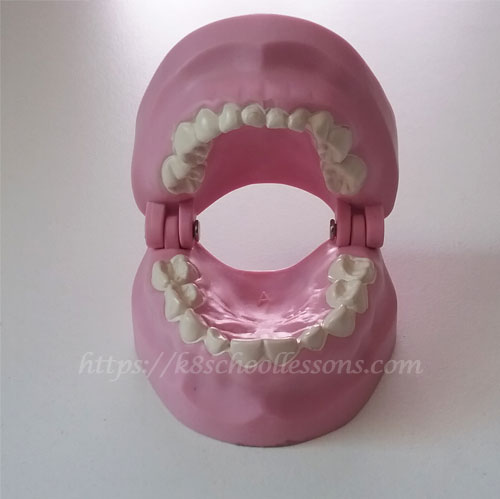 An Artificial set of Primary Teeth
An Artificial set of Primary Teeth
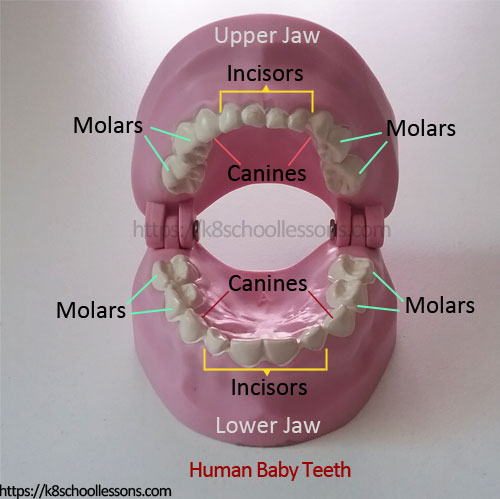 Human Baby Teeth Chart – Types of Baby Teeth
Human Baby Teeth Chart – Types of Baby Teeth
Primary Teeth Eruption at different ages
The lower central incisors (lower front middle teeth) usually come in first, and then teeth begin appearing on either side and work their way back to the second molars. The process begins to repeat itself when the child is about five to six years old.
 Primary Teeth Eruption at Different Stages
Primary Teeth Eruption at Different Stages
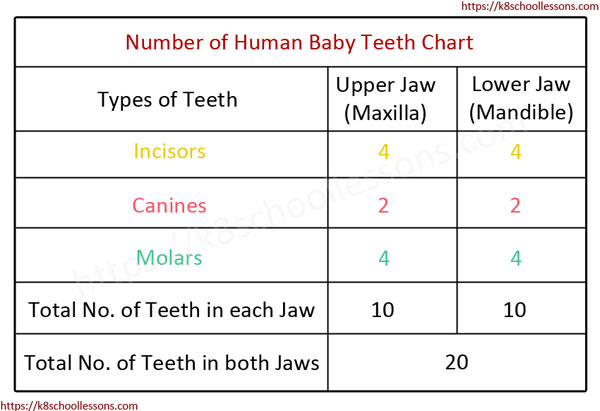 Number of Teeth Chart – Number of Baby Teeth
Number of Teeth Chart – Number of Baby Teeth
Permanent Teeth
Not only the set of primary teeth, but also the set of permanent teeth develop even before a child is born. Inside the gums, the set of permanent teeth is layered underneath the set of primary teeth on both upper and lower jaws. When the right time comes, a primary tooth falls out because it is being pushed out of the way by the permanent tooth that is behind it. Slowly, the permanent teeth grow in and take the place of the primary teeth.
There are 28 permanent teeth in all. This is eight more than the original set of baby teeth. Between the ages of 17 and 21, four more teeth called wisdom teeth usually grow in at the back of the mouth. They complete the adult set of 32 teeth.
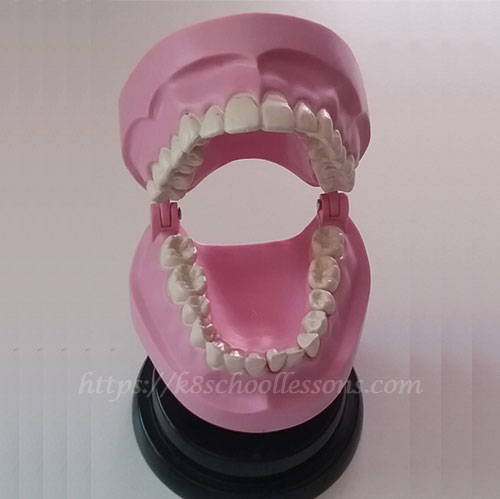 An Artificial set of Permanent Teeth
An Artificial set of Permanent Teeth
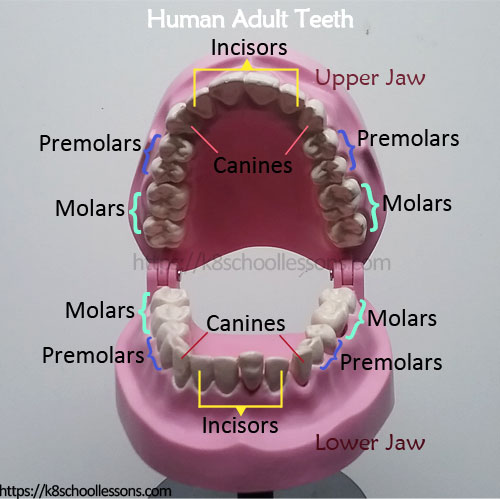 Human Adult Teeth Chart – Types of Adult Teeth
Human Adult Teeth Chart – Types of Adult Teeth
Permanent Teeth Eruption at different ages
The central incisors fall out first and are replaced by permanent teeth. At the age of 6, the first permanent molar comes out behind the baby teeth. And at the age of about 12, the second permanent molar comes out as well. Both teeth do not require the fall out of baby teeth. By about age 12 or 13, most kids have lost all of their baby teeth and have a full set of permanent teeth.
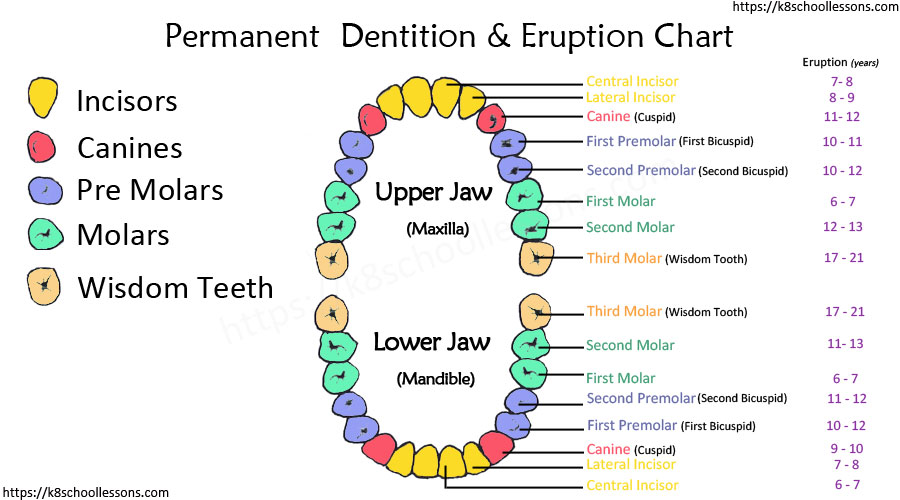 Permanent Teeth Eruption at Different Stages
Permanent Teeth Eruption at Different Stages
Types of teeth
What are the types of teeth?
As we learned above, there are four main types of teeth.
- Incisor
- Canine (Cuspid)
- Premolar (Bicuspid)
- Molar

Types of Teeth Chart
Functions of teeth
What are the functions of teeth?
Your teeth look different from one another because they are designed to do different things.
| Types of Teeth | Functions |
| Incisors | Cut food like a knife |
| Canines | Grip and tear food |
| Premolars | Crush and grind food up |
| Molars | Crush and grind food up, help to swallow food |
Incisors
The teeth in the very front are the incisors
.
No.of incisors: Eight in all. Upper jaw: 4 incisors Lower jaw: 4 incisors
Shape of the incisors: Sharp and shaped like tiny chisels with sharp flat ends
Function of the incisors: Cutting and chopping food
The Tooth Incisor
Canines
The pointy teeth beside your incisors are the canines. The canines have very long roots as they are meant for grasping and tearing food.
No.of canines: Four altogether. Upper jaw: 2 canines Lower jaw: 2 canines
Shape of the canines: Pointy and sharp
Function of the canines: Grasping and tearing food
The Tooth Canine
Premolars
You can see the premolars just behind the canine teeth, but in front of the molars. Locating in front of the molars is the reason for these teeth to be called as premolars. These are also called bicuspid teeth.
No.of premolars: Eight in all. Upper jaw: 4 premolars Lower jaw: 4 premolars
Shape of the premolars: Bigger, stronger, have ridges and a flatter chewing surface
Function of the premolars: Crushing and grinding food

The Tooth Premolar
Molars
The last teeth towards the back of your mouth are the molars. You have to open your mouth really wide, if you want to see them. According to the time they come in, molars are sometimes called 6-year molars and 12-year molars. Molars are the toughest of all types of teeth.
No.of molars: Eight altogether. Upper jaw: 4 molars Lower jaw: 4 molars
Shape of the molars: Wider and stronger than premolars, and have more ridges
Function of the molars: Crushing and grinding food, Working closely with the tongue to help you swallow food.
The Tooth Molar
Wisdom Teeth
The last teeth a person gets are the wisdom teeth. These are also known as third molars. They are all the way at the back of the mouth, one in each corner. Wisdom teeth usually appear between the ages of 17 and 25.
Most adults have four wisdom teeth. However, some people have more than four wisdom teeth. We call these extra wisdom teeth, supernumerary teeth.
Sometimes, wisdom teeth can affect other teeth as they develop, becoming impacted or coming in sideways. In such case, they are often extracted.
Why are they called wisdom teeth?
It’s believed that they’re called wisdom teeth because they come in later in life, when a young person is older and wiser.
